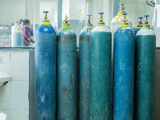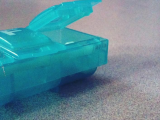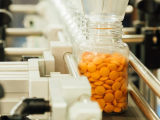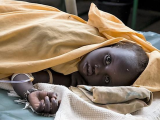The hashtag "There is no insulin" (or انسولین_نیست#) trended across Iran and beyond on Twitter in mid-October. Although the Iranian government said that more insulin would be available to be distributed, shortages still occurred at least through early December, and no long-term solutions have surfaced.
In 2011, an estimated 11.4% of the adult population in Iran had diagnosed diabetes, and recent articles report that Iran has more than 5 million diabetic residents, with more than 600,000 needing daily insulin injections.
While a World Health Organization (WHO) representative for Iran was not able to be reached for comment, a WHO media contact was unsure if a shortage was still occurring due to a drop in local media coverage. Iranians who still use the hashtag have crowdsourced insulin and bemoaned spot shortages, hours-long delays and bureaucratic frustrations, and rationing.
While tweets have slowed and some speak of improvement—a photo of locations with insulin, for instance—testimonies of supply issues remain. Additionally, a few people have expressed exhaustion over not only advocating for insulin but also over COVID-19 concerns.
Sanctions, smuggling, corruption
While Iranians have experienced past shortages of insulin, on Oct 8, an additional factor may have played a part in escalating the situation: The Trump administration added sanctions targeting 18 Iranian banks. Sanctions are supposed to have provisions allowing for the flow of medicines and other humanitarian necessities, but their mere existence can be enough to tangle business dealings.
According to The Balance, by the fourth quarter of 2019, 60% of known central bank foreign exchange reserves worldwide took place in US dollars, with the euro, the second closest currency, at 20%. Most international dealings go through US banks, so on the one end, companies may be hesitant to incur violations, and on the other end, Iranian payments often run against processing barriers.
Corruption and drug smuggling have also been stated as possible causes for insulin shortages, but not by the Iranian government.
One of the most recent examples of possible corruption comes from an Oct 14 report by Iraqi military intelligence, who confiscated a large medical cargo of drugs—including 19 trucks full of medicine such as insulin—departing Iran. In the wake of the incident, Iranian health ministry officials had mixed stories, first saying the cargo was bought from Iranian pharmacies before stating it was purchased from Turkey, India, Indonesia, China, and the United Arab Emirates.
Either way, the numbers that Iran's Ministry of Health touts do not line up with the actual output of insulin. Insulin imports rose 13% in the first half of the year, rising $73 million to $82 million, yet insurance sales fell $42 million to $39 million in the same period, according to Radio Zamaneh, adding that insulin must be exiting the supply chain somewhere before the intended end point.
Just 2 weeks ago, Mahsa, an Iranian resident, wrote in an email interview, "I don't have a good source or evidence to tell how many people get insulin from [the] black market, but I know we can find it there easily." While some insulin was still available on the black market this fall, several reports claim its prices had risen. Mahsa adds, "If there isn't insulin, why they [on the black market] have it, and if there is, so what is these [sic] awful crisis and shortage!"
Mahsa had penned a blog titled, "There Is No Insulin in Iran" in late October for the type 1 diabetes advocacy nonprofit T1International. She uses only her first name to keep anonymity.
Domestic sources not enough
Back in the fall, Kianush Jahanpur, the head of public relations at Iran's Ministry of Health, received backlash after advising on Twitter that patients experiencing insulin shortages should lower their dosage, writes Radio Zamaneh (translated on Medium), but his poor remarks ended up ringing true for some Iranians.
Less inflammatory but just as weighty was the advice from Iran's Food and Drug Administration head, Mohammad Reza Shanehsaz. According to Asia Times, he suggested people switch from insulin pens to the abundant human vials.
Diabetic patients can switch insulin types, but without guidance, they can have issues with converting quantity, allergic reactions, monitoring, and injecting techniques.
One Iranian insulin user on Twitter, @IDostovar, wrote about his experience simply looking for advice on how to make the change, saying he couldn't find anything on Google. Another Twitter user, @Tracutil, provided what he was looking for with a six-part public thread outlining dosage reduction and timing changes. A Radio Zamaneh anonymous source also related their experience, telling the news agency that the transition from their normal source to Iranian-produced insulin could take a whole month and require constant blood sugar monitoring.
Iran currently has two domestic insulin lines: Basalin, a product by Iran-based biopharmaceutical company Pooyesh Darou, and insulin from Novo Nordisk Pars, a subsidiary of Novo Nordisk.
In June, Pars Today relayed an Iranian Student News Agency report saying Basalin was safe and effective. However, some Iranians have continued to be worried about its quality. This has been further exacerbated by a Radio Zamaneh investigation, which said, "A source from the Iranian pharmaceutical Pooyesh Darou confirmed that the Iranian version of Basalin is a 'transfer of technology' from a Chinese company 'bought by Sandoz.'"
As for Novo Nordisk, its first insulin production line began at the end of August after several years of importing insulin products to sell in the country. Bourse and Bazaar wrote that the company promised to save Iran 25 million euros in the first year and 45 million euros in the second year after insulin production started.
Thus far, critics have accused Novo Nordisk of exorbitant prices. In the Asia Times story, Madiar Saeedian, MD, editor in chief of the Danestaniha-ye Pezeshki medical journal in Tehran, claimed Novo Nordisk charged $6 per insulin pen, compared with other European countries who charged $2 to $3. Prices are agreed upon between Novo Nordisk and Iranian health authorities.
Both shortages, solutions difficult to quantify
As of late November, government pharmacies were rationing insulin supplies as patients attempt to get their prescriptions, according to Radio Zamaneh.
"There's a general frustration sense that the government and authorities are not taking the issue seriously enough despite patients struggling," said T1International founder and executive director Elizabeth Pfiester, MSc, in early December. "In terms of what we [T1] can do, our role in these situations is mainly to amplify the voices of those with diabetes who are most directly impacted"—a similar role that those outside of Iran are limited to as well. For now, no definitive solutions have been announced.
The status of Iran's insulin supply and allocations remains murky. Perhaps the government has been able to procure enough insulin, but it appears to be a work in progress. Either way, Iran had an insulin crisis for months, and some patients are still reeling from it.
As Mahsa said in early December, "I can say nothing's changed here. I myself have my store of insulin, but I see my friends who have to seek for insulin in every pharmacy we know, and if they are lucky they can find some pens."






















